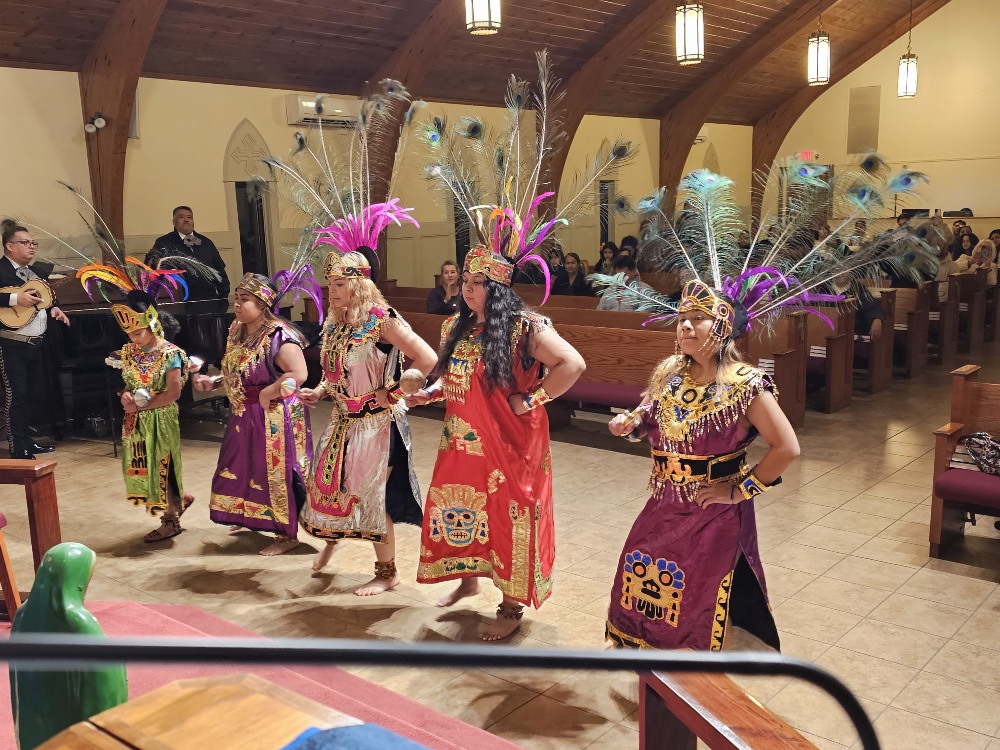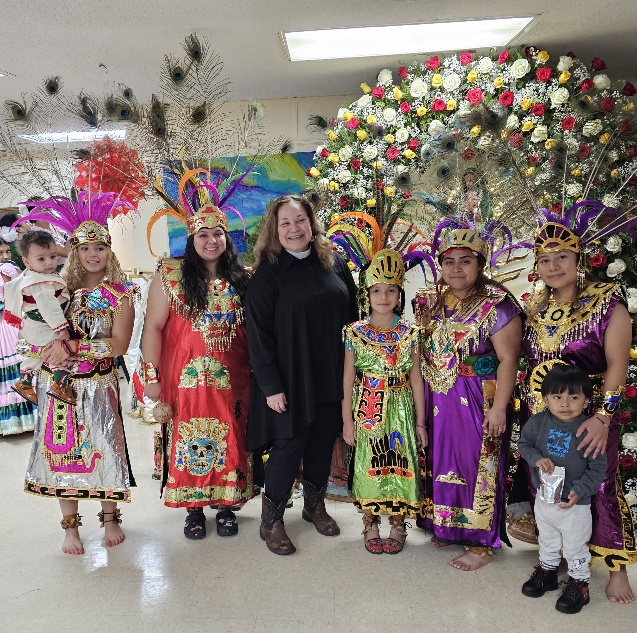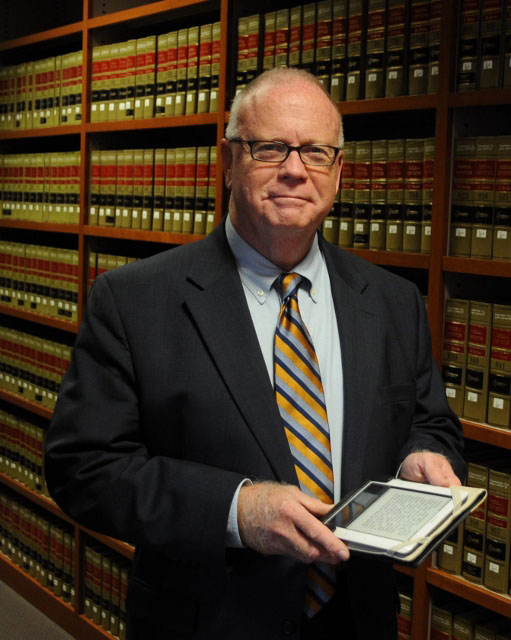A 400-year-old tradition is taking root in parishes throughout The Episcopal Diocese of Atlanta.
It’s the Feast of Our Lady of Guadalupe, otherwise known as the Virgin of Guadalupe, celebrated on and around Dec. 12.
This year, St. Bede’s Atlanta, Christ Church Norcross, St Jude’s Smyrna, St. Augustine Morrow, Holy Innocents’, and El Buen Pastor Austell were among those celebrating the feast with services, Mariachi, traditional Hispanic food, and reenactments of 16th Century Chichimec peasant Juan Diego receiving visions of Our Lady of Guadalupe (see images).
While millions of people make a pilgrimage to the Basilica of Our Lady of Guadalupe in Mexico City every year, the celebration is relatively recent among Episcopal parishes in the Diocese.
St. Bede’s, located just inside I-285 near LaVista Road, was one of the first parishes in the Diocese to adopt the tradition. After beginning as a service primarily for Hispanic congregants, the service has been for all parishioners since 2012, said The Very Rev. Chad Vaughn, St. Bede’s Rector.

Vaughn and Diocese of Atlanta Hispanic Missioner The Rev. Irma Guerra led this year’s bilingual celebration, accompanied by the Rev. Raymond Walker III, and an enthusiastic multicultural congregation, The Rev. Deacon Iñaki Guevara-Cuence said.
“The origin of this holiday occurred when the Virgin Mary appears to Juan Diego, specifically on the Tepeyac hill in 1531,” said Deacon Guevara-Cuence.
St. Bede’s Youth Group represented the story of the appearance of the Virgin.

Rev. Guerra reflected on meaning of the service for the Mexican community and their Christian faith.
“The Virgin of Guadalupe gave the Indian Juan Diego a delicate treatment of nobility, prophetically elevating the condition of all his people. The Lord ‘brings down the mighty from their thrones and exalts the humble.’ At the same time, The Virgin brought reconciliation and not division between the natives and the Spanish. She helped them both understand that the Christian faith is not the property of anyone but a gift of love for all,” Guerra said.
“Four hundred years had to pass for Western culture to recognize with admiration that the image printed on the indigenous ayate was a true Mexican codex, a message from heaven loaded with symbols. Helen Behrens, a North American anthropologist, discovered in 1945 what the eyes of the Indians had ‘read’ in the painting as ‘Mother of the true God by whom one lives’ in that December of 1531.” (read the full reflection in Spanish and English)
Christ Church in Norcross also celebrated Our Lady of Guadalupe with a bilingual service with Mariachis. Rev. Guerra, who pastors the Hispanic congregations at St. Bede’s and Christ Church, said Our Lady of Guadalupe is a symbol of religion and national pride to the people of Mexico.
Reflecting on the effect of the service, Deacon Guevara-Cuence said it has improved the quality of life for St. Bede’s congregants.
“Funny how your quality of life improves drastically when you surround yourself with good, intelligent, kind-hearted positive, loving people,” Guevara-Cuence said.
The Episcopal Diocese of Atlanta has 13 parishes with dedicated Hispanic congregations. Learn more about the Diocese’s Hispanic Ministry.

The following are reflections from Rev. Mimi Guerra…
Our Lady of Guadalupe
The wonderful visit of the Virgin occurred on Tuesday, December 12, 1531, just ten years after the conquest of Mexico. The mother of God comes to make the gospel known to the poor defeated Indians and to “show and give” all her “love and compassion, help and defense.”
For four days the Virgin had communicated with Juan Diego speaking to him in his own language, Nahualtl. When identifying herself, María used the word “coatlallope”; a compound noun formed by “coatl” that is, snake, the preposition “a” and “llope”, to crush; that is, she was defined as “the one who crushes the serpent.” Others reconstruct the name differently anyway; it sounded to the ears of the Spanish friars like “Guadalupe.” The Virgin communicated in a way that both the Indians and the Spanish understood her!
The Virgin of Guadalupe gave the Indian Juan Diego a delicate treatment of nobility, prophetically elevating the condition of all his people. The Lord “brings down the mighty from their thrones and exalts the humble.” At the same time, The Virgen brought reconciliation and not division between the natives and the Spanish. She helped them both understand that the Christian faith is not the property of anyone but a gift of love for all.
Four hundred years had to pass for Western culture to recognize with admiration that the image printed on the indigenous ayate was a true Mexican codex, a message from heaven loaded with symbols. Helen Behrens, a North American anthropologist, discovered in 1945 what the eyes of the Indians had “read” in the painting as “Mother of the true God by whom one lives” in that December of 1531.
LA GUADALUPANA
La maravillosa visita de la Virgen ocurrió el martes 12 de diciembre de 1531, apenas diez años después de la conquista de México. La madre de Dios viene para dar a conocer el evangelio a los pobres indios vencidos y para “mostrar y dar” todo su “amor y compasión, auxilio y defensa”
Durante cuatro días la Virgen se había comunicado con Juan Diego hablándole en su propia lengua, el náhualtl. Al identificarse, María usó la palabra “coatlallope”; un sustantivo compuesto formado por “coatl” o sea, serpiente, la preposición “a” y “llope”, aplastar; es decir, se definió como “la que aplasta la serpiente.” Otros reconstruyen el nombre diferente de todas formas esto sonó a los oídos de los frailes españoles como “Guadalupe. ¡La Virgen se comunicó de manera que la entendiesen tanto los indios como los españoles!
La Virgen de Guadalupe dio al indio Juan Diego un delicado trato de nobleza elevando proféticamente la condición de todo su pueblo. El Señor “derriba del trono a los poderosos y enaltece a los humildes.” Al mismo tiempo, La Virgen trajo reconciliación y no división entre los nativos y los españoles. Les ayudó a ambos a comprender que la fe cristiana no es propiedad de nadie sino un don de amor para todos.
Cuatrocientos años debieron pasar para que la cultura occidental reconociera admirada que la imagen impresa sobre el ayate indígena era un verdadero códice mexicano, un mensaje del cielo cargado de símbolos. Helen Behrens, una antropóloga norteamericana descubrió en 1945 lo que los ojos de los indios habían “leído” en la pintura como “Madre del verdadero Dios por quien se vive” en aquel diciembre de 1531.

